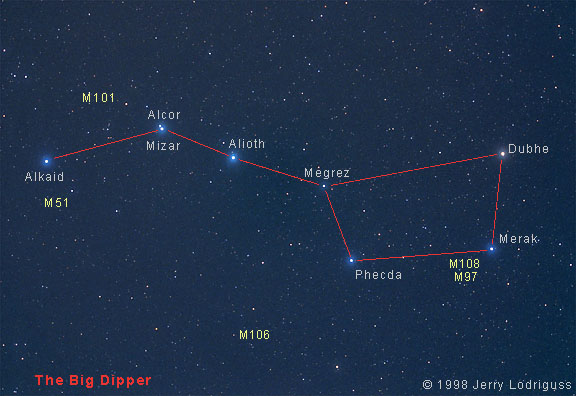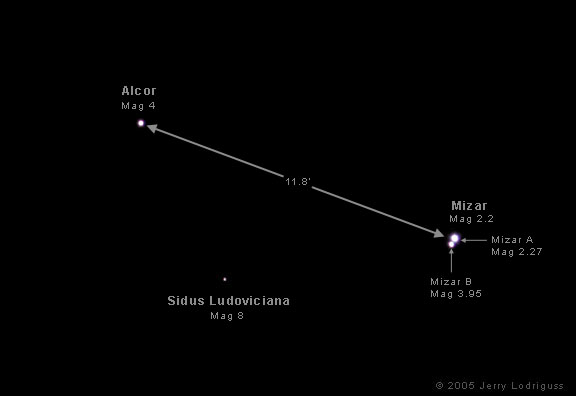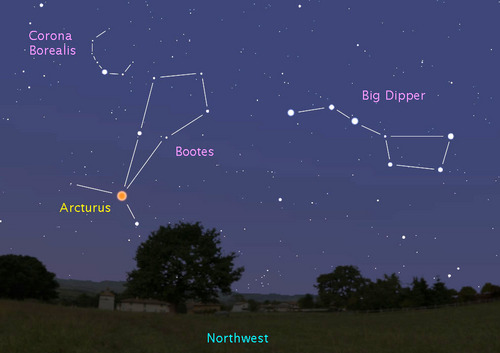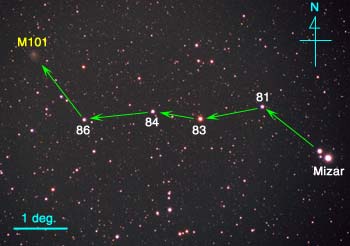"The lessons of science should be experimental also. The sight of a planet through a telescope is worth all the course on astronomy; the shock of the electric spark in the elbow outvalues all theories; the taste of the nitrous oxide, the firing of an artificial volcano, are better than volumes of chemistry." -Ralph Waldo Emerson
As a theorist, one of the challenges I face is bringing the experimental and observational sides of what we study to all of you. I understand its importance, its significance, and how it is the ultimate arbiter of our understanding. And yet, it is not my strongest suit. Nonetheless, tomorrow night (the 19th) is an important milestone: the date I take my astronomy students up to the observatory to view the night sky!
What's sort of amazing is how much you can see through just a simple telescope -- even in less-than-ideal conditions -- even if you know almost nothing about astronomy.
Let me take you through it, assuming you live in the Northern Hemisphere and only know how to find one thing:
The Big Dipper! The most easily identifiable object in the Northern Skies, if all you can do is find this guy, here's how you -- given good, dark skies -- can find a whole slew of beautiful objects! Now, before we get going, you need to know that the more light pollution you have -- i.e., the lower your elevation, the closer you are to cities, and the fuller the Moon is -- the less able you'll be to see faint and diffuse objects. Let's get on with it!

You'll need to get your bearings, and that means finding true North. In the Northern Hemisphere, we are guided by the North Star, which is easy to find if you know your Big Dipper! Simply take the last two stars in the "cup" portion of the dipper and follow them up and out of the cup; they'll run into Polaris, the bright pole star and the edge of the handle in the Little Dipper!
Here in April, the Big Dipper stars out high in the sky after Sunset, making it the ideal guidepost for your night-sky hunting. The dipper itself is made up of seven stars... or is it?

Just barely visible to the naked eye is the fact that the second star in the handle of the Big Dipper is actually a double star. But if you point your telescope at it, know what you'll find?
It's actually four stars! Mizar is a binary star system, where both stars appear very bright, and there is a faint star behind and between Alcor and Mizar, visible only through (good) binoculars or a telescope.
But the Big Dipper can not only lead you to Polaris, it can lead you to a couple of the brightest and most spectacular stars in the Northern Hemisphere. Let's start with #1!
If you follow the curve of the handle through space for a little while, you'll come to Arcturus (make an "arc to Arcturus"), the orange giant that is the brightest star in the Northern Hemisphere! Unfortunately for you telescope enthusiasts, there's nothing remarkable about it through a telescope.
But instead of following the handle, try following the two stars that make up the top of the Dipper's cup.
They take you, going away from the Dipper's handle, to Capella, the third brightest star in the Northern Hemisphere (and sixth overall)! Capella is notable for being the brightest star that's also close to the North Pole (and hence is the most seen bright star in the Northern Skies year-round), but through a telescope, Capella is something special.
Capella is actually a double yellow giant! Two yellow giant stars, in close orbit around one another, that never eclipse one another! (In other words, any time you look at them, you'll always be able to see two distinct, non-overlapping stars.)
But if you get a really good telescope, you won't just see the two yellow giants...

You'll see that Capella is a pair of binaries! The two yellow giants and two red dwarf stars.
Not bad for stars, simply by being able to find the Big Dipper. What if you wanted to go beyond stars, and find a beautiful planetary nebula?

Guess what? There's one in the Big Dipper! In the 18th Century, Charles Messier made the first catalogue of "non-cometary" objects in our night skies. Only four of them were planetary nebulae, or stellar corpses of red giants that have blown off their outer layers. One of them -- the Owl Nebula, or M97 -- is right there, just below the bottom of the "cup" of the Dipper!
The two dark "eyes" give it its name, although perhaps today it would be called the Amy Winehouse nebula? While it's one of the fainter nebulae in the sky, its compactness means it's going to be visible even with substantial light pollution through a reasonably-sized telescope. Originally around the mass of our Sun, the Owl Nebula is only about 6,000 years old, with about 15% of the Sun's mass making up the glowing, "nebular" region.
But what if you're dissatisfied with stars or nebulae? What if you want to find some galaxies? Luckily for you, the Big Dipper can help you find three of the most spectacular ones. Let's start with the easiest.

Go directly "below" the last star in the handle, perpendicular to the line it makes with the Alcor/Mizar double star next to it. That's the location of the Whirlpool Galaxy, M51, one of the most spectacular (and one of the brighter) face-on spirals in our sky!
If you had a really good telescope, you might see something like this...
Of course, you likely don't have Hubble, but with good skies, you can see the companion galaxy, NGC 5195, even with large binoculars or a small telescope! Those pink regions in M51 are real, not false color, and are emission lines from star-forming regions.
Want a challenge? Try to find one of the faintest face-on spiral galaxies near the Big Dipper:
M101! Start at Mizar/Alcor, and follow the line that Mizar makes with Alcor. That should take you to a fairly bright star, labeled "81" above. Bend "down" (back towards the Dipper's handle) and follow the rough "line" of brighter stars until you've hit four in a row, and then head back "up" (away from the Dipper's handle) one last time; that fuzzy blob is M101, the Pinwheel galaxy!
Only visible in places with low light pollution, M101 is a challenge for amateur observers. But for Hubble...
I certainly don't expect to see this, polluted by bright city skies (and a nearly full Moon tomorrow night), but it is certainly worth a try!
But there is one more candidate that I would like to try for, the great galaxy pair, M81 and M82. How to get there?
Take the last star in the "cup" of the Big Dipper (the last of the pointer stars that points towards the North Star) and the one diagonally down from it. (Dubhe and Phecda, respectively.) Connect Phecda to Dubhe, and continue on in an imaginary line for the same distance, and that should plunk you down very close to a pair of bright, interacting galaxies, M81 and M82!
With dark skies and a good telescope, these are spectacular. With city skies and a moderately-sized scope, they may be visible at all... we'll see.
And those are some amazing sights available to you, even if all you have is a simple telescope, and even if all you know is the Big Dipper! And for those of you who are way ahead of me, tomorrow night, what objects do you recommend viewing with a 16" scope under heavy light pollution? I know that Saturn is up...













This is an awesome blog. I don't have a telescope but I just started trying to figure out the night sky by using ursa major. This is a very informative blog. Thank you
I'm always a big fan of globular clusters, such as M15 and M13 (haven't looked up which are up now). I also love to use Sky & Tel's info:
http://www.skyandtelescope.com/observing/ataglance
This is a great start for first time telescope users. I have one suggestion, but you'll have to look for it early in your session as it sets around 10:30 pm tomorrow night.
Most people if they can find anything besides the Big Dipper, it's usually the constellation Orion. The easy naked eye contrast is between the red super giant Betelgeuse and the blue hot Rigel (or Sirius to the east). But buried in the hunter's sword is, of course, M42, the Orion Nebula, the easiest stellar nursery to spot even in a small 'scope. Most first timers are fascinated by the wispy blue texture of that giant hydrogen cloud as they consider the astrophysical processes going on there.
And then, using Orion like you did the Big Dipper, follow the shoulders off to the northwest to find Aldebaran, another red giant and the blood-red eye of Taurus the bull. Finally, continue on to find the open cluster M45, the Pleiades, the 7 sisters (or Subaru, if you drive a Japanese car of that make) in their sparkling, diamond-like splendor.
Well, if you're willing to go as late as midnight or so, Albireo in Cygnus is a great binary, of course. And before that, while you're in the area, there's the Ring Nebula, hard to make out in the city, but I've certainly done it with a 4" pretty easily. You probably wouldn't want to even try until it got up higher, though, while Albireo should be pretty good as soon as you can see it.
If you're following the Dipper handle curve to Arcturus, why not keep going to Spica? :) That's how I've usually seen it.
Oh, and even before Lyra comes up, M13 in Hercules, absolutely. You could go for M44 in Cancer before it sets, too.
The ring nebula is a good view even in light polluted skies. The major problem is working out where the clucking bell it is, 'cos with a low power eyepiece needed to find it it looks like a dim star. With a power you can view it as a non-stellar object you have to hunt like billy-o.
PS Saturn is still well visible and you can now see the gap between the planet and the rings.
This blog rocks. Hardcore. I just last week purchased my first telescope (besides the dinky Wal-Mart toy I had when I was a kid) and I got some great viewing of the moon, and was searched for Saturn for a bit, but I didn't find it as clouds came rolling it. Aside from that I was mostly just wandering. Now I've got at least half a dozen objects I'm pretty confident I can find! Thanks Ethan!
Now to just wait until I get some clear skies. Ain't it the way, I got one clear night since I bought it, and the moon was big and bright. New moon is coming up in early May I think, though.
Mizar?! Let's conquer it! (Sorry, much of this stuff as I read, I think I still know more Star Trek. Just Google "Mizarian" if you must know.)
So I think you did this once a LONG while back - perhaps even before moving to ScienceBlogs - but might you consider doing a telescope (and/or binocular) buyer's guide for those of us who keep thinking about getting into this but haven't yet? Maybe after that an amateur's use guide? I had a (cheap) telescope as a kid and could never get it pointed at anything. Once I got a good look at the moon. ONCE!
WHAT BenHead SAID! Please. I have no idea whatsoever where to start looking.
However, that's rather like asking for a routeplanner's guide for hitchikers who want to go across the USA but PLEASE don't use those long weird names!
If you have ABSOLUTELY NO IDEA what you're getting in to, get a planisphere and join the dots up when you go outside. E.g.
"If that's orion, then just over there, those two stars must be Ursa Minor, which means that that house there is hiding Sirius, so that should be up in an hour...".
Other alternatives:
1) Go to a star party.
2) Go to a real observatory on open day
3) Get a star map like, say, Redshift or Stellarium
4) Just go outside with a set of binoculars and a recliner/deckchair
5) Buy one of the cheap small GOTO refractors you can get (the more expensive option, though now around $300) and use the "What's on" button a lot
6) Browse the NASA webpages on the HST
OK. Fair enough.
I can't use a 'scope that requires any internet connection because I'm in rural WVa. I have a steady base (the ground), and I know how to use a star chart, so I don't need to be told what I'm looking at. I can spot Orion, Arcturus, Polaris, Saturn, Venus, etc., with my eyes. I already have a excellent pair of Nikon 12X50 binoculars, so I can see planetary moons, etc. They don't mount on a tripod, so that limits their use. I am willing to spend between $500-1,000.
Does that help at all?
@greame: According to amateur astronomers' lore, every telescope delivery includes extra clouds in the box for packing material. If it hadn't been cloudy since you got it, I'd be worried about damage during shipping.
"I can't use a 'scope that requires any internet connection"
The internet connection isn't needed for a scope. However, you can get an Astronomy mag that will have an astronomy package. The GOTO scopes have a database of what's up there (though often not tailored to the scope, so you get things you can't have any chance of seeing, since a handset with 35,000 objects "sells" better than one with 3,000 that you have some chance of seeing).
If you're looking to get mostly planets and the smaller stuff rather than big views like "All the Pleiades" or "Andromeda" (which, to be frank, doesn't look inspiring visually), then you're probably best to go for a GOTO scope with either a 90mmMak or 100mmMak.
These scopes are long focal length but well folded up so the tube itself isn't very long.
Get one with a Red Dot Finder.
That will cost you something less than $500.
Get used to what it sees and when you know what you're looking at and for, you can spend another $500 and get either
1) A big Newtonian on a GEM mount that lets you look at the faint fuzzies or get wider "picture" views
2) A small astrograph-quality refractor on a *good* GEM so you can take photos
3) A long focal length refractor that is easier to focus and gets you better views of planets and other small bright objects
The smaller Mak scope will still get used because the other choices are more specific. This may be a reason to go for the cheaper 90mm.
Pity about the Binos, but get a lounger and lie down. You get about an extra magnitude of visual discrimination if you can hold them steady. Resting them on your eyesockets works just as well as mounting on a tripod. It's just you can't show off what you've seen without vague pointing and hoping.
(GEM = German Equatorial Mount)
Ethan, your students are lucky to have you as their teacher. We are too.
I'll print and take your tour, not tomorrow though. Thanks.
This is a great tutorial! I love checking out constellations, but I often lose patience with myself when I can't find certain ones.
I would definitely appreciate more blog posts like this! Show us more!
Stellarium is free software that is excellent at helping you find your way around the sky.
A good telescope for anyone interested is the 10" zhumell telescope at telescopes.com for around $450
Large support community at cloudynights.com
Nice!! I really enjoy visiting this blog. Always something awesome waiting me. ;)
I wish we could clone you and have you as an astronomy teacher in every high school in america but I guess I'll have to settle for your blog instead keep up the stellar work it is truly appreciated
No comments except this God is very very Great
Not as great as a 16" SCT on a firm and correctly aligned mount.
anyone know of a good Blackberry 9700 App to find the North Star for telescope alignment?
Any tilt and electronic compass won't really be any help if you can't see the North Pole Star by eye.
And what constitutes finding it depends on the mount used. A GEM and you can use a compass and spirit level.
If you can see the Big Dipper, draw a line along the front edge of the pan. The pole star is along that line. Opposite and nearly equally distant is Cassiopeia. A big W.
If you get any sort of star map program for your blackberry then you'll be able to use it to find the constellations and their angle from your location.